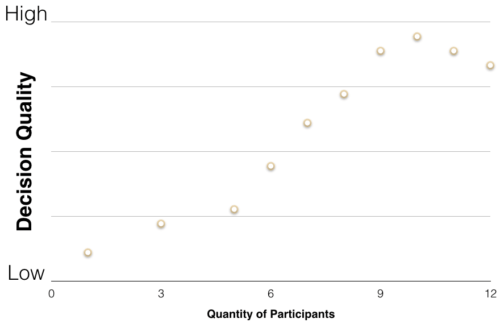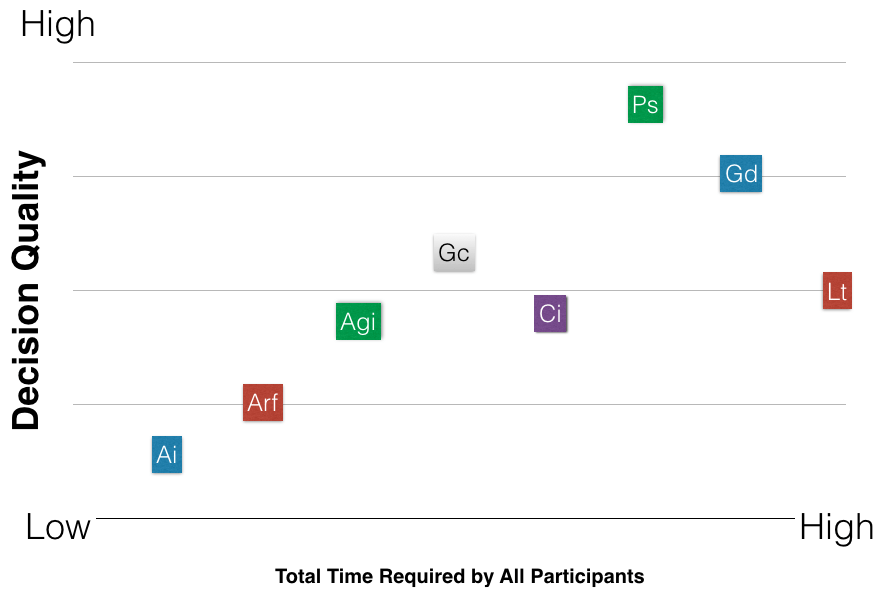We have applied modern research about decision quality with material found in Vroom and Yetton’s robust volume, “Leadership and Decision-Making”. Here they identify eight group decision-making styles.
Research proves that groups make higher-quality decisions than the smartest person in the group (i.e., individuals). Therefore, it is relatively easy to picture the relationship as shown in the following array of potential group decision-making styles:
Next, understand the eight styles and then watch what happens when we array them against a new chart, with the “X-Scale” representing how much time is invested by group members and the “Y-Scale” representing the tendency from authoritative decision-making to completely collaborative decision-making.
First the eight styles:
- Ai Autocratic or directive style: The leader defines the problem, diagnoses the problem, generates potential solutions, evaluates the options, and selects among the best options.
- Agi Autocratic with group input: The leader defines the problem and conducts some diagnosis. They look to the group for the cause and potential solutions, and then unilaterally select among the best options.
- Arf Autocratic with group review and feedback: The leader defines the problem, diagnoses probable causes, and selects a solution from among the best options. The leader presents their plan to the group for understanding, review, and feedback, and frequently to transfer ownership.
- Ci Individual consultative style: The leader defines the problem and shares it with the individual members of the group. The leader solicits ideas around probable causes and potential solutions. After obtaining information, the leader selects among the best options.
- Gc Group consultative style: Similar to the Ci described above the sharing occurs with the group as a whole, rather than as segmented individuals.
- Gd Group decision style: The leader shares the problem with the entire group. The group diagnoses probable causes, generates options, evaluates against criteria, and selects among the best options.
- Ps Participative: The group as a whole identifies and agrees on the problem. They continue to diagnose probable causes, generate options, evaluate against criteria, and select among the best options. The role of the leader serves as a true facilitator.
- Lt Leaderless team: The group has no formal leader, but assembles. Often a leader emerges and may bias the problem or solution. However, the group still The group diagnoses probable causes, generates options, evaluates against criteria, and selects among the best options.
Implications
Having arrayed them in the chart above, it becomes apparent, that critical decisions demand more group time while simple and tactical decisions should be managed by individuals and not macro-managed by groups or supervisors. The next time you are faced with a critical decision, demand the time to take a facilitated group approach, and you will be amazed at what a solid group of subject matter experts can generate when properly facilitated as defined by the Ps style above.
______
Don’t ruin your career by hosting bad meetings. Sign up for a workshop or send this to someone who should. MGRUSH workshops focus on meeting design and practice. Each person practices tools, methods, and activities every day during the week. Therefore, while some call this immersion, we call it the road to building high-value facilitation skills.
Our workshops also provide a superb way to earn up to 40 SEUs from the Scrum Alliance, 40 CDUs from IIBA, 40 Continuous Learning Points (CLPs) based on Federal Acquisition Certification Continuous Professional Learning Requirements using Training and Education activities, 40 Professional Development Units (PDUs) from SAVE International, as well as 4.0 CEUs for other professions. (See workshop and Reference Manual descriptions for details.)
Want a free 10-minute break timer? Sign up for our once-monthly newsletter HERE and receive a timer along with four other of our favorite facilitation tools, free.

Terrence Metz, MBA, CSM, CSPF, PSP01, HTTO1, is the Managing Director of MG RUSH Facilitation Leadership, Training, and Meeting Design, an acknowledged leader in structured facilitation training, and author of “Meetings That Get Results – A Facilitator’s Guide to Building Better Meetings.” His FAST Facilitation Best Practices blog features nearly 300 articles on facilitation skills and tools aimed at helping others lead meetings that produce clear and actionable results. His clients include Agilists, Scrum teams, program and project managers, senior officers, and the business analyst community among numerous private and public companies and global corporations. As an undergraduate of Northwestern University (Evanston, IL) and an MBA graduate from NWU’s Kellogg School of Management, his professional experience has focused on process improvement and product development. He continually aspires to make it easier for others to succeed.



